We’re in corn country, you generally don’t see any livestock around here unless [it’s] waste ground.”
Matt Rice (30) knew he was breaking the mould of traditional crop farming in Philo, Champaign County, Illinois, when he started his Angus and Angus-Hereford cross suckler herd five years ago.
But following his father Dirk, grandfather Don and great grandfather Nathan’s approach to conservation agriculture he was confident to “give it a try”, he told the Irish Farmers Journal during the closing days of harvest 2023 in late October.
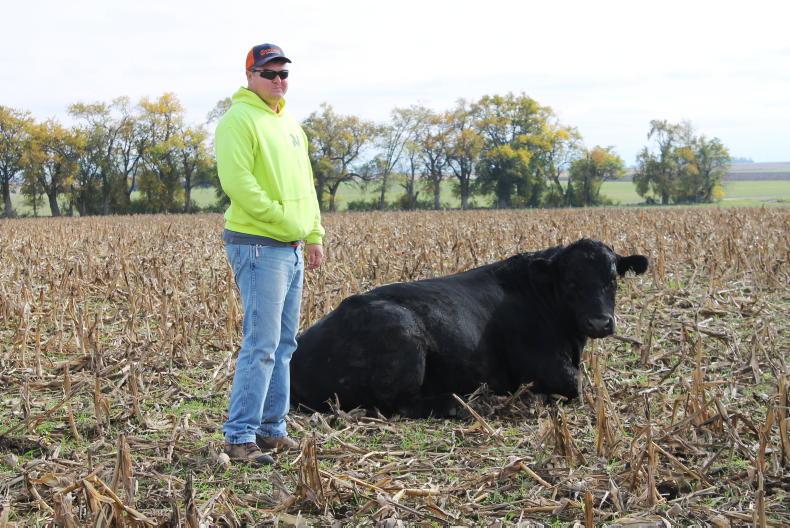
Matt Rice with his Angus bull on his farm. \ Claire McCormack
“I thought: ‘we don’t have livestock, but what we do have is an unlimited amount of cornstalks’. We’ve access to cheap protein supplements from byproducts at nearby corn and ethanol plants too.
“It wouldn’t be a green pasture system, but we had a lot of forage we could utilise.”
Matt’s growing herd is comprised of 40 cow-calf pairs with all stock outdoors 90% of the year rotating between paddocks across the 2,100ac corn (maize) and soya bean holding.
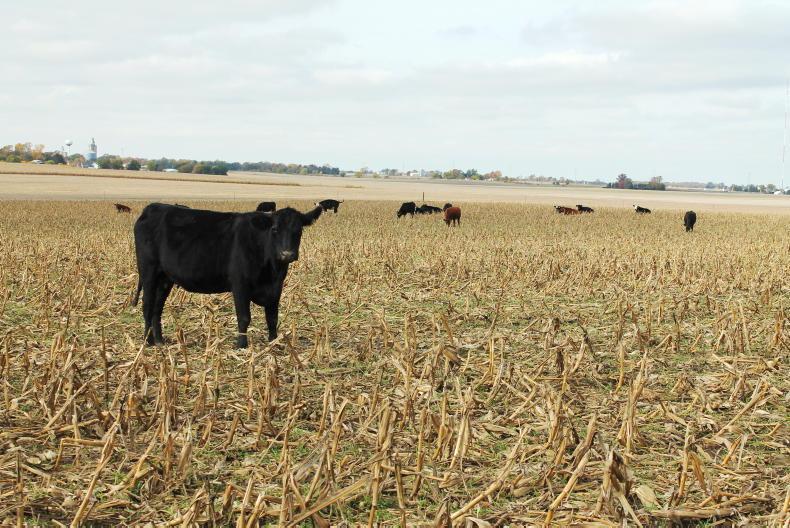
Cows cornstalk grazing on the Rice farm. \ Claire McCormack
He calves indoor and outdoor (50-50) in late February or early March.
He sells weanlings at nine months of age, mainly to feedlots through on-farm sales. He is content with his feeding system to date.
“You can run cows on cornstalks most of the winter. Once they’re done eating the shucks you have to supplement, they do pretty good on it.
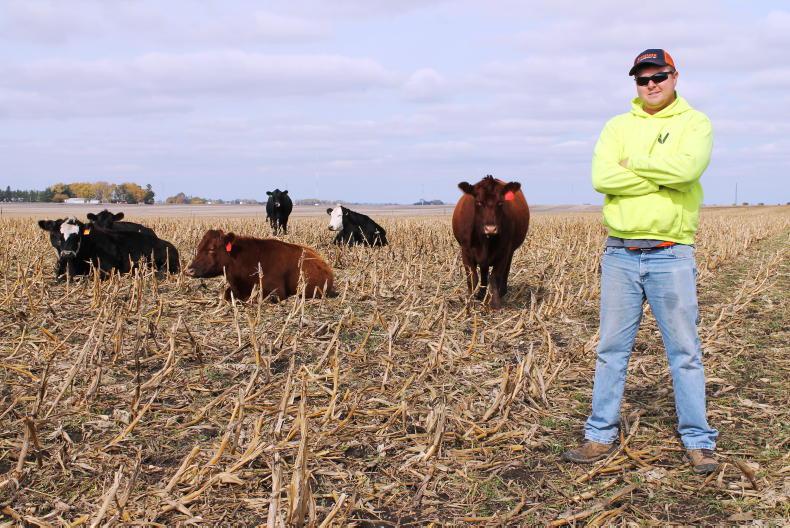
Matt Rice with the suckler stock on his farm. \ Claire McCormack
“The shucks and leaf are the most easily digested part of the cornstalk and once they’re gone, you either supplement or move to fresh cornstalks.
“I just planted a plot in sorghum sudangrass for the cows and calves to graze this winter too instead of making hay. They get more minerals and good vitamins out of it as opposed to what you lose in the haymaking process.
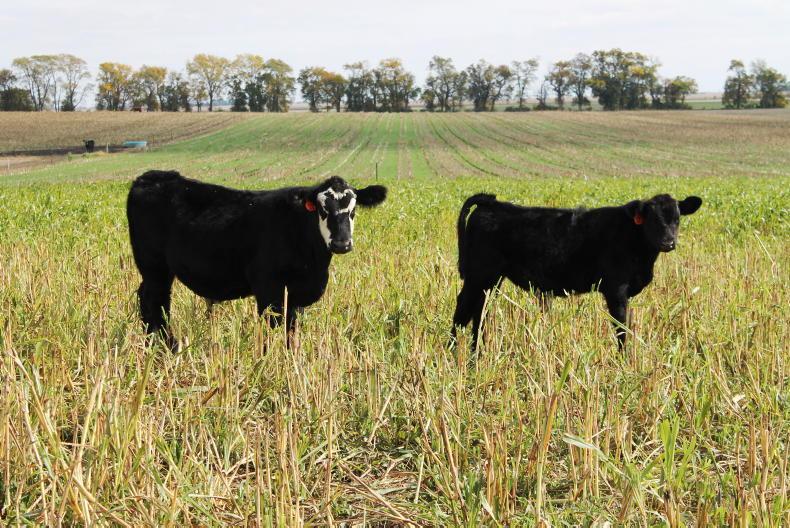
Calves grazing on the Rice holding in Illinois. \ Claire McCormack
“Right now, they’ve been on the same 80ac for a month, basically one acre per cow per month. I’ve lots of cornstalks around the house so I’ll move them pretty quick.”
Wind breaks
With few hedgerows or trees to act as wind breaks or shelter, the agribusiness graduate of South Illinois University Carbondale, stacks bales to make wind blocks and puts straw down to keep them out of the mud, particularly during calving.

Calves grazing on the Rice holding in Illinois. \ Claire McCormack
“Our cows struggle more in the heat of summer than the cold of winter, so I’d rather calve when there are no flies and no heat stress. I work hard to get the calves warmed up if there happens to be bad weather, but come June or July when it’s 100°[Fahrenheit] (37°C) at 90% humidity, I’m sure glad to be done with that.
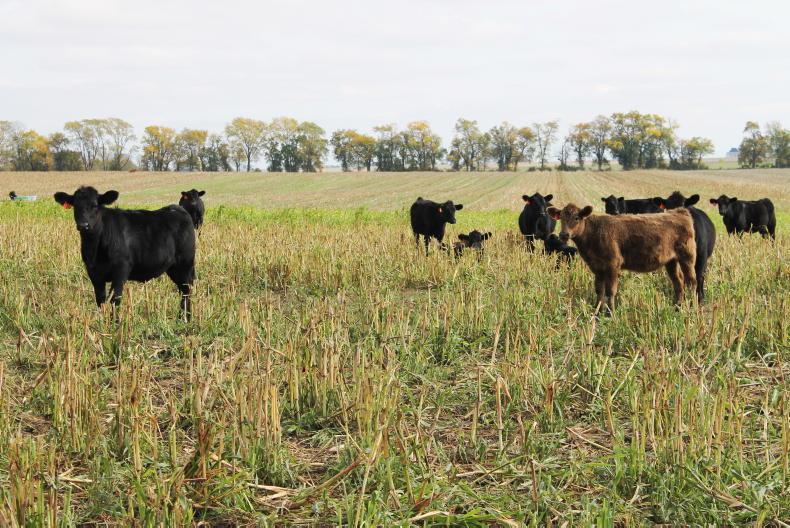
Calves grazing on the Rice holding in Illinois. \ Claire McCormack
“If there is a bad storm coming in, I’m checking them a couple of times in the middle of the night, every night. But if the sun is shining, and I can keep them out of the wind, I’m not scared of having them calve outside as long as they have a strong calf. They’re a hardy breed.”
We’re in corn country, you generally don’t see any livestock around here unless [it’s] waste ground.”
Matt Rice (30) knew he was breaking the mould of traditional crop farming in Philo, Champaign County, Illinois, when he started his Angus and Angus-Hereford cross suckler herd five years ago.
But following his father Dirk, grandfather Don and great grandfather Nathan’s approach to conservation agriculture he was confident to “give it a try”, he told the Irish Farmers Journal during the closing days of harvest 2023 in late October.

Matt Rice with his Angus bull on his farm. \ Claire McCormack
“I thought: ‘we don’t have livestock, but what we do have is an unlimited amount of cornstalks’. We’ve access to cheap protein supplements from byproducts at nearby corn and ethanol plants too.
“It wouldn’t be a green pasture system, but we had a lot of forage we could utilise.”
Matt’s growing herd is comprised of 40 cow-calf pairs with all stock outdoors 90% of the year rotating between paddocks across the 2,100ac corn (maize) and soya bean holding.

Cows cornstalk grazing on the Rice farm. \ Claire McCormack
He calves indoor and outdoor (50-50) in late February or early March.
He sells weanlings at nine months of age, mainly to feedlots through on-farm sales. He is content with his feeding system to date.
“You can run cows on cornstalks most of the winter. Once they’re done eating the shucks you have to supplement, they do pretty good on it.

Matt Rice with the suckler stock on his farm. \ Claire McCormack
“The shucks and leaf are the most easily digested part of the cornstalk and once they’re gone, you either supplement or move to fresh cornstalks.
“I just planted a plot in sorghum sudangrass for the cows and calves to graze this winter too instead of making hay. They get more minerals and good vitamins out of it as opposed to what you lose in the haymaking process.

Calves grazing on the Rice holding in Illinois. \ Claire McCormack
“Right now, they’ve been on the same 80ac for a month, basically one acre per cow per month. I’ve lots of cornstalks around the house so I’ll move them pretty quick.”
Wind breaks
With few hedgerows or trees to act as wind breaks or shelter, the agribusiness graduate of South Illinois University Carbondale, stacks bales to make wind blocks and puts straw down to keep them out of the mud, particularly during calving.

Calves grazing on the Rice holding in Illinois. \ Claire McCormack
“Our cows struggle more in the heat of summer than the cold of winter, so I’d rather calve when there are no flies and no heat stress. I work hard to get the calves warmed up if there happens to be bad weather, but come June or July when it’s 100°[Fahrenheit] (37°C) at 90% humidity, I’m sure glad to be done with that.

Calves grazing on the Rice holding in Illinois. \ Claire McCormack
“If there is a bad storm coming in, I’m checking them a couple of times in the middle of the night, every night. But if the sun is shining, and I can keep them out of the wind, I’m not scared of having them calve outside as long as they have a strong calf. They’re a hardy breed.”












 This is a subscriber-only article
This is a subscriber-only article









SHARING OPTIONS: